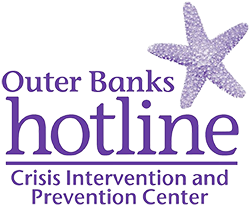A safety plan is a set of actions that you have thought about and rehearsed to lower your risk of being hurt by your partner. When you leave a relationship, it has the potential to be more dangerous; safety planning is especially important during this time.
If you feel you are in immediate danger or in an emergency, always call 911.
Keep the Outer Banks Hotline’s Crisis line number with you. You can reach us at any time.
Safety Planning During Escalating or Explosive Incidents
Remember that your judgement and clarity can be influenced by your partner, fear, and trauma. By creating a safety plan, you are mentally and physically preparing yourself for any situation.
- Leave money, extra keys, copies of important documents, extra medicines, and clothes with someone you trust or in a safe place.
- Think about the risk of physical danger to yourself and others. How strong is your partner and how much force are they willing to use?
- Identify your clearest exit route. What are some potential weapons or obstructions? If possible, keep weapons like guns and knives locked away.
- Always keep your cell phone on you. What is your backup phone? Memorize what numbers to call for help.
- Consider technology and how you can stop your abuser from tracking you. Refer to this technology safety plan.
- Create realistic reasons for leaving the house during situations that have a pattern of escalating or have potential to become dangerous.
- Choose one or more neighbors you can trust. Tell them about the violence and ask them to call the police immediately if they hear a disturbance coming from your home.
- Talk to your children about what to do during escalating or explosive incidents. Explain the importance of keeping their distance from the violence. Establish a signal to leave the house and where they can go to be safe. Teach them how to call 911.
- Practice how to exit your home safely. Identify which doors, windows, elevators, or stairwells would be best for a quick escape. Are your children capable of following you? Do they need to be carried? Consider any pets and what you will do with them.
- Consider your clothing or accessories. Are you wearing anything that could be used to hurt you such as jewelry or a scarf?
- Think about your escape vehicle / transportation. Keep your car fueled and the driver’s door unlocked. If possible, keep a copy of your car keys hidden where only you can access them.
- If an argument seems unavoidable, try to stay away from the kitchen, bedroom or anywhere else weapons might be available.
- If you can’t escape, move to a corner and curl into a ball with your face protected and arms around each side of your head, fingers entwined.
Safety Planning with Children
- Teach your children who to contact during an emergency: friends, family members, neighbors, or local shelters. Teach them when and how to call 911.
- Plan with your children how to handle a confrontation that is escalating. Where is a safe place to go? Who can you trust to be available during a crisis?
- Establish a secret code word or signal for when they should leave the house.
- Choose a room in the house that they can escape to when they’re scared. Is there something in that room that can comfort them?
- Teach them what areas of the house to avoid when a situation is worsening. For example, kitchens and bathrooms contain dangerous items.
- Explain why they must not get involved in any violence and what actions they can take instead.
- Be mindful that your children may be questioned by your partner and what to do if any of your secrets are shared.
Safety Planning with Pets
While your personal safety should always be your top priority, it is important to consider how your pets fit into any plan you make to leave home.
- Take steps to prove ownership of your pets. Have them vaccinated and licensed in the place where you live, making sure the registrations are done in your name. Take the steps necessary to have them changed if necessary.
- If possible, avoid leaving pets with an abusive partner.
- If your pet is microchipped, make sure your abusive partner is not listed as a contact.
- If you are planning to leave, talk to friends, family or your veterinarian about temporary care for your pet if necessary.
- If you decide to leave, bring extra provisions for your pet including food, medications, copies of their medical records and important phone numbers.
- If you are thinking about getting a protective order, find out if your state allows pets to be included in such orders.
Safety Planning During Pregnancy
If your partner is emotionally or physically abusive, being pregnant can worsen your partner’s behavior. Establish a safety plan for you and your baby.
- Seek help from your doctor. Your health care provider can play an active role in giving you the tools, resources, and support to leave an abusive relationship.
- If your partner goes to the doctor with you, look for any moment when they aren’t near. Tell the doctor or nurse that you need to speak with them alone, and they will provide an excuse to get a one-on-one conversation with you.
- Try to find a birthing class for mothers only. When you get the chance, ask for help from the instructor. Talk with them about you and your baby’s safety.
- You are at an increased risk of harm when you’re pregnant. Try to stay on the first floor and away from stairs. If violence is unavoidable, curl into a ball and cover your stomach.
